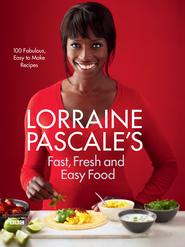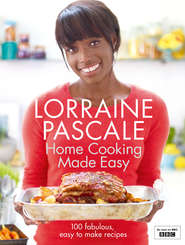По всем вопросам обращайтесь на: info@litportal.ru
(©) 2003-2024.
✖
Baking Made Easy
Настройки чтения
Размер шрифта
Высота строк
Поля
1 egg, lightly beaten, for glazing
Preheat the oven to 210°C (415°F), Gas Mark 6–7. Dust a large baking tray with flour.
Put the flour, baking powder, salt, butter and sugar in a food processor and pulse until the mixture resembles breadcrumbs. Add the mascarpone, then pulse again for 3 seconds. (If you don’t have a food processor, put all the ingredients in a medium bowl, pick up chunks of butter covered in flour and rub them between your thumbs and forefingers. Add the mascarpone and continue ‘rubbing in’. This shouldn’t take more than about 5 minutes.)
Pour the mixture into a large bowl and make a hole in the centre, then pour in enough milk to make a soft dough and stir with a knife. Use both hands to bring the mixture together, and squeeze, making sure any dry bits get picked up. It may seem like a crumbled mess but keep squeezing and the dough will come together. Knead lightly for a few seconds just to make the dough smooth and then roll out quickly on a lightly floured surface to about 2cm (¾in) thick.
Cut out rounds using a 6cm (2½in) round cutter (though any size will do) and place them on the prepared baking tray. It’s important not to twist the cutter whilst doing this or the scones won’t rise evenly when baked. Squish together any leftover dough, roll out and cut out more scones.
Brush the tops with beaten egg and bake in the oven for 10–12 minutes, or until the scones are nicely risen, firm and golden brown. Remove from the oven and leave to cool a little on the tray. They are best served fresh and warm from the oven with lashings of clotted cream, strawberry jam and a pot of tea.
Brioche Rolls
The easiest way to make brioche is in an electric mixer with a dough hook. You can make it by hand, but you’ll need some time and a whole heap of patience. As an alternative to a brioche mould you can use a deep muffin tin. For a variation, soak some raisins in Madeira for an hour, dry them well, toss in flour (to stop them from sinking during baking) then add them to the dough once all the butter has been added. Makes 12
Vegetable oil or spray oil, for oiling
500g (1lb 2oz) plain flour, plus extra for dusting
1½ sachets of fast-action dried yeast (10g/1/3oz)
2 tsp salt
3 tbsp soft light brown sugar
6 cold eggs, lightly beaten
310g (11oz) butter, softened
1 egg, lightly beaten, for glazing
Equipment
12 mini brioche moulds or a 12-hole deep muffin or cupcake tin
Oil the moulds or muffin or cupcake tin.
Put the flour in an electric mixer with the yeast, salt and sugar. Add the eggs, two at a time, mixing well between each addition on a slow speed. Once the eggs are all added, mix for 8 minutes. With the mixer still on a low speed add the butter in 5 additions, making sure that each bit of butter is well mixed in before the next is added. Every couple of minutes or so, scrape the sides of the bowl down with a spatula to make sure that all of the dough is fully mixed in. This process of adding the butter takes a good 10 minutes on the machine. The mixture will go from a stiff ball of stretchy hopelessness to something silky and smooth once all the butter is incorporated.
Once all the butter has been added keep mixing it until the dough no longer sticks to the side of the mixing bowl.
If you are doing this by hand the dough will look like a big runny sticky mess initially and keep sticking badly to the work surface. Just keep pulling the dough up and then pushing it down and scraping it off the work surface so you are continuously stretching and moving it. Eventually the dough will become less sticky, more elastic and begin to be a little easier to handle. It is tempting to throw in more flour so that it is less sticky, but doing this will change the brioche recipe altogether and make it more like regular bread. This may take up to 20–25 minutes or more. The dough will still be very soft at this stage.
Once the dough is ready, divide it into a third and two-thirds. Take the larger piece and divide it into 12 equal pieces. With well-floured hands take one of the pieces and make a ball with it, push it down into the mould or tin, then with a floured finger make a big hole in the middle. Repeat with the rest of this piece of dough. Then take the smaller third piece and break it into 12 portions. Roll each one into a bullet shape so it has a round ball at the top and a long pointed end. Push the pointed end into the hole all the way down so only the top third of the bullet is showing. Repeat with the rest of the dough. Alternatively, if by this stage you have had enough of your brioche, which, believe me, can happen, you can freeze it for up to a month by wrapping in clingfilm or putting it into a freezerproof bag and come back to it another day once it is defrosted and you are ready to conquer it again.
Oil the top of the bread and cover loosely with clingfilm, making sure it is airtight. Leave in a warm place until the dough has almost doubled in size, about 2–3 hours (this takes longer than other breads due to the high fat content).
Preheat the oven to 200°C (400°F), Gas Mark 6.
Once risen, remove the clingfilm and brush the dough well with the lightly beaten egg. Place in the top half of the oven, making sure there is room for the brioche to rise, and bake for about 35 minutes, or until the brioche is a rich golden brown and comes out of the moulds or tin easily. Take a peek after about 20 minutes of cooking. If you feel that the top is getting too dark, just cover the brioche with some baking paper to give the centre a chance to cook without any further browning to the surface. Remove the brioche from the oven and leave to cool in the tin.
Brioche has many uses. It makes an enticing breakfast bread, especially when spread with butter and served warm. Sliced, it can be served with foie gras and a rich chutney. For an extra special pud, make a large brioche and use it to make a bread and butter pudding.
Spiced fruit
Tea Loaf
A traditional English tea bread, spiked with spices and dried fruit. Makes 1 small loaf
Vegetable oil or oil spray, for oiling
180g (6½oz) strong white bread flour
180g (6½oz) plain flour, plus extra for dusting
1 tbsp ground ginger
1 tbsp ground cinnamon
1 x 7g sachet of fast-action dried yeast
1 tbsp soft light brown sugar
1 tsp salt
Grated zest of 1 lemon
1 egg, plus 1 egg, lightly beaten, for glazing
1 tbsp treacle
150ml (5fl oz) warm water
80g (3oz) sultanas
60g (2½oz) dates, chopped
Equipment
22 x 10cm (8¾ x 4in) loaf tin
Oil and line the loaf tin with baking paper.
Put the flours, ginger, cinnamon, yeast, sugar, salt and lemon zest in a medium bowl. Make a hole in the centre and pour in the egg, treacle and warm water. Mix to a soft dough, then transfer to a floured work surface and knead the dough for 10 minutes by hand or for 5 minutes in an electric mixer fitted with a dough hook. This dough is quite wet, which makes for a lighter loaf but can be tricky to knead initially. The more it is kneaded the less sticky it will get. Try not to add any more flour.
Once the dough is kneaded, plop it back in a bowl (if you are doing it by hand), or if using a machine remove the bowl (with the bread still in it) from the machine. Add the sultanas and dates. Knead the bread in the bowl for 1 minute to make sure all the fruit is evenly distributed. Then shape into a ball and plop it into the prepared loaf tin.
Squish the bread down at the corners slightly and then cover loosely with clingfilm, making sure it is airtight. Leave in a warm place until the bread has almost doubled in size.







